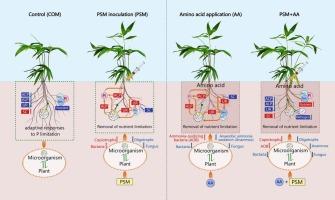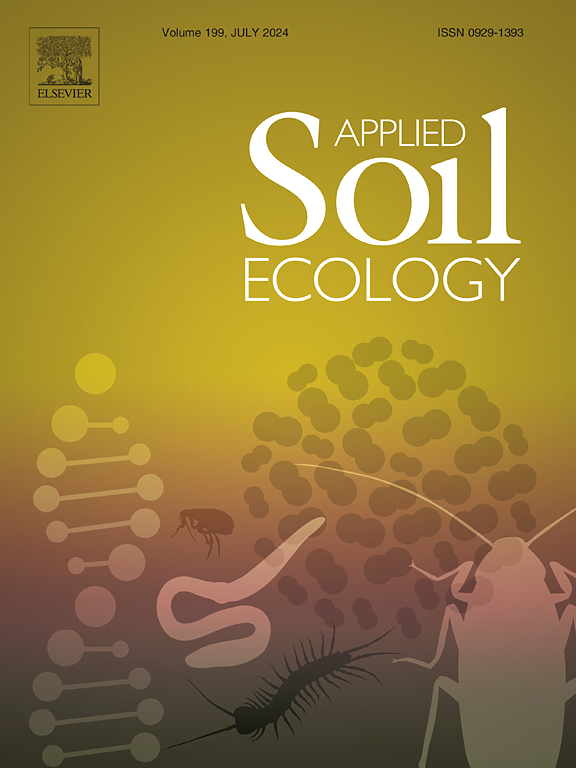Enhancing phosphorus-solubilizing microorganism potential for alleviating plant phosphorus limitation through amino acid co-application
IF 4.8
2区 农林科学
Q1 SOIL SCIENCE
引用次数: 0
Abstract
Phosphorus-solubilizing microorganisms (PSMs) are recognized as a sustainable ecological strategy to mitigate plant phosphorus (P) limitation. However, their efficacy in real-world production scenarios is not as consistent as observed in controlled laboratory conditions. To deepen our comprehension of PSMs in mitigating plant P limitation and evaluate the efficacy of combined amino acids (AA) and PSMs application in optimizing plant nutritional environments, we conducted a study, aiming to preliminary delineate the model of plant-microbe-soil interactions facilitated by this joint approach. Phyllostachys edulis seedlings were cultivated in phosphorus-limited soil with or without AA and PSMs application. We assessed treatment impacts on plant growth and soil nutrient conditions through plant biomass, root morphology, tissue nitrogen (N) and P content, soil N and P contents, rhizosphere microbial communities, and soil enzyme activities. Application of AA and PSMs significantly enhanced shoot growth of P. edulis seedlings, reduced root ratio, modified root morphology, increased N and P content in plant tissues, facilitated conversion of soil insoluble P to active forms, and raised total soil N, alkali-hydrolysable N, ammonium N, and nitrate content. Moreover, it influenced the structure and function of the soil microbial community. Notably, soil enzyme activities under the combined application exhibited distinctions from individual applications, demonstrating greater similarity to the treatment without AA and PSMs, which received no additional amendments. Our findings underscored the significant positive impact of the combined AA and PSMs application on P. edulis seedling growth, improving soil nutrient status, enriching plant growth-promoting rhizobacteria, and reducing soil diseases. However, plant-soil-microbe interactions induced by the combined application might differ from those observed with individual applications, necessitating further experimentation for a comprehensive understanding.

通过氨基酸共用提高磷溶解微生物缓解植物磷限制的潜力
磷溶解微生物(PSMs)被认为是缓解植物磷(P)限制的一种可持续生态策略。然而,它们在实际生产环境中的功效并不像在受控实验室条件下观察到的那样一致。为了加深我们对 PSMs 在缓解植物磷限制方面的理解,并评估氨基酸(AA)和 PSMs 的联合应用在优化植物营养环境方面的功效,我们进行了一项研究,旨在通过这种联合方法初步构建植物-微生物-土壤相互作用的模型。我们在施用或不施用 AA 和 PSMs 的限磷土壤中栽培了 Phyllostachys edulis 幼苗。我们通过植物生物量、根系形态、组织中氮(N)和磷(P)含量、土壤中氮(N)和磷(P)含量、根瘤微生物群落和土壤酶活性来评估处理对植物生长和土壤养分条件的影响。施用 AA 和 PSMs 能显著促进水稻幼苗的生长,降低根系比率,改变根系形态,增加植物组织中的氮和磷含量,促进土壤中不溶性磷向活性形式的转化,提高土壤总氮、碱水解氮、铵态氮和硝酸盐含量。此外,它还影响了土壤微生物群落的结构和功能。值得注意的是,联合施用下的土壤酶活性与单独施用下的土壤酶活性有所不同,显示出与未施用 AA 和 PSMs 的处理更为相似,后者没有额外的改良剂。我们的研究结果表明,联合施用 AA 和 PSMs 对 P. edulis 幼苗生长、改善土壤养分状况、丰富植物生长促进根瘤菌和减少土壤病害有显著的积极影响。然而,联合施用所引起的植物-土壤-微生物之间的相互作用可能与单独施用所观察到的有所不同,因此有必要进行进一步的实验来全面了解。
本文章由计算机程序翻译,如有差异,请以英文原文为准。
求助全文
约1分钟内获得全文
求助全文
来源期刊

Applied Soil Ecology
农林科学-土壤科学
CiteScore
9.70
自引率
4.20%
发文量
363
审稿时长
5.3 months
期刊介绍:
Applied Soil Ecology addresses the role of soil organisms and their interactions in relation to: sustainability and productivity, nutrient cycling and other soil processes, the maintenance of soil functions, the impact of human activities on soil ecosystems and bio(techno)logical control of soil-inhabiting pests, diseases and weeds.
 求助内容:
求助内容: 应助结果提醒方式:
应助结果提醒方式:


